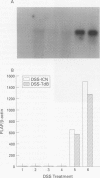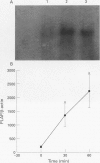Abstract
BACKGROUND: Crohn's disease and ulcerative colitis are idiopathic inflammatory bowel diseases (IBD) involving synthesis of eicosanoids from arachidonic acid (AA), which is released from membrane phospholipids by phospholipase A2 (PLA2). A potentially important regulator of the production of these mediators is a protein activator of PLA2, referred to as PLA2 activating protein (PLAP). AIMS: The purpose of this investigation was to discover if PLAP values might be increased in the inflamed intestinal tissue of patients with IBD and in intestinal tissue of mice with colitis. PATIENTS: Biopsy specimens were taken from patients with ulcerative colitis and Crohn's disease undergoing diagnostic colonoscopy, and normal colonic mucosa was obtained from patients without IBD after surgical resection. METHODS: Immunocytochemistry with affinity purified antibodies to PLAP synthetic peptides was used to locate PLAP antigen in sections of intestinal biopsy specimens from IBD patients compared with that of normal intestinal tissue. Northern blot analysis with a murine [32P] labelled plap cDNA probe was performed on RNA extracted from the colons of mice fed dextran sulphate sodium (DSS) and cultured HT-29 cells exposed to lipopolysaccharide (LPS). RESULTS: PLAP antigen was localised predominantly within monocytes and granulocytes in intestinal tissue sections from IBD patients, and additional deposition of extracellular PLAP antigen was associated with blood vessels and oedema fluid in the inflamed tissues. In contrast, tissue sections from normal human intestine were devoid of PLAP reactive antigen, except for some weak cytoplasmic reaction of luminal intestinal epithelial cells. Similarly, colonic tissue from DSS treated mice contained an increased amount of PLAP antigen compared with controls. The stroma of the lamina propria of the colonic mucosa from the DSS treated mice reacted intensely with antibodies to PLAP synthetic peptides, while no reaction was observed with control mouse colons. These data were supported by northern analysis which showed that PLAP mRNA was increased in the colons of DSS treated mice and cultured HT-29 cells exposed to LPS. CONCLUSIONS: As PLAP values were increased in the intestinal mucosa of IBD patients and mice with colitis, as well as in LPS treated cultured HT-29 cells, a role was postulated for PLAP in increasing PLA2 activity, which leads to the increased synthesis of eicosanoids in intestinal tissues of patients with these inflammatory diseases.
Full text
PDF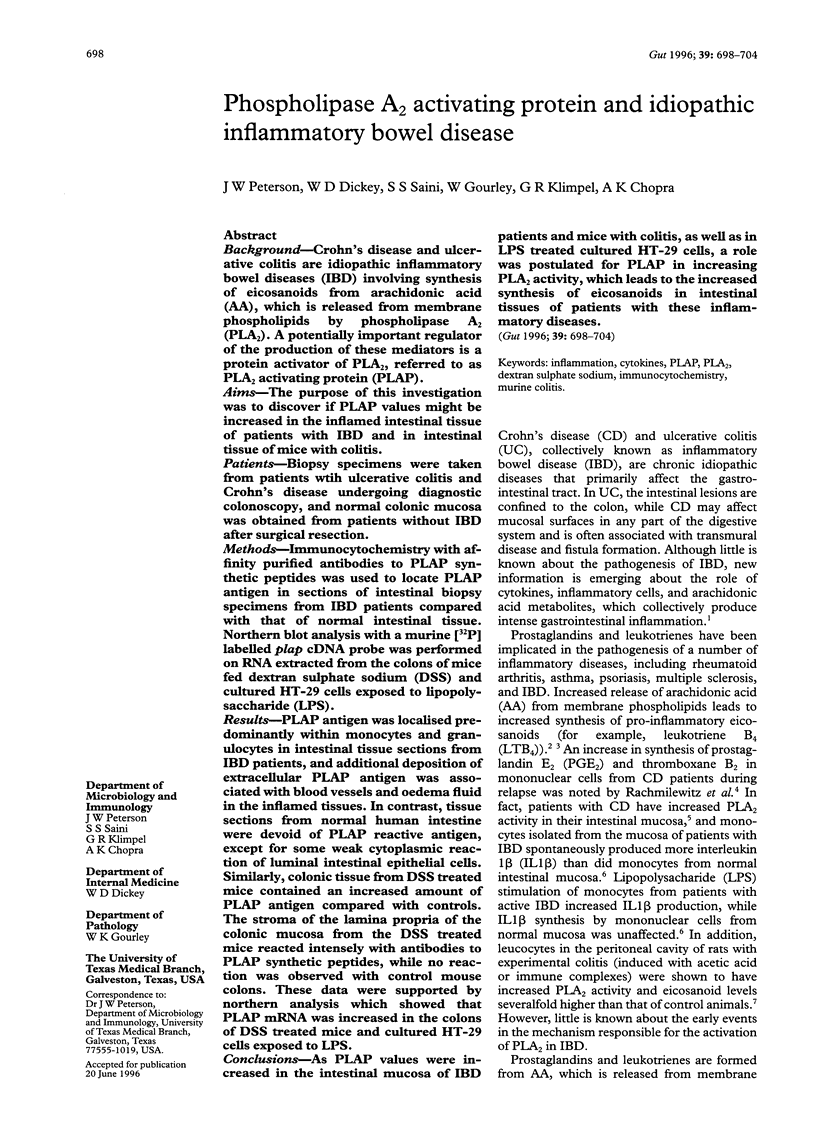
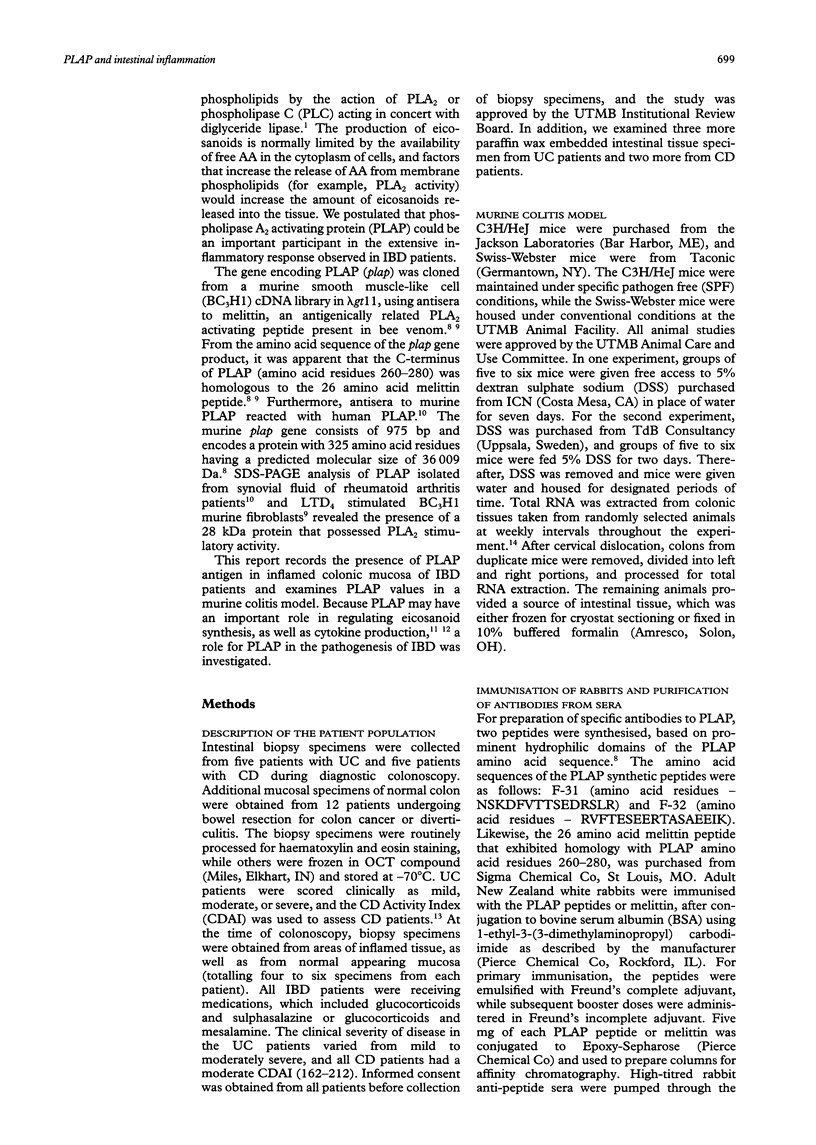
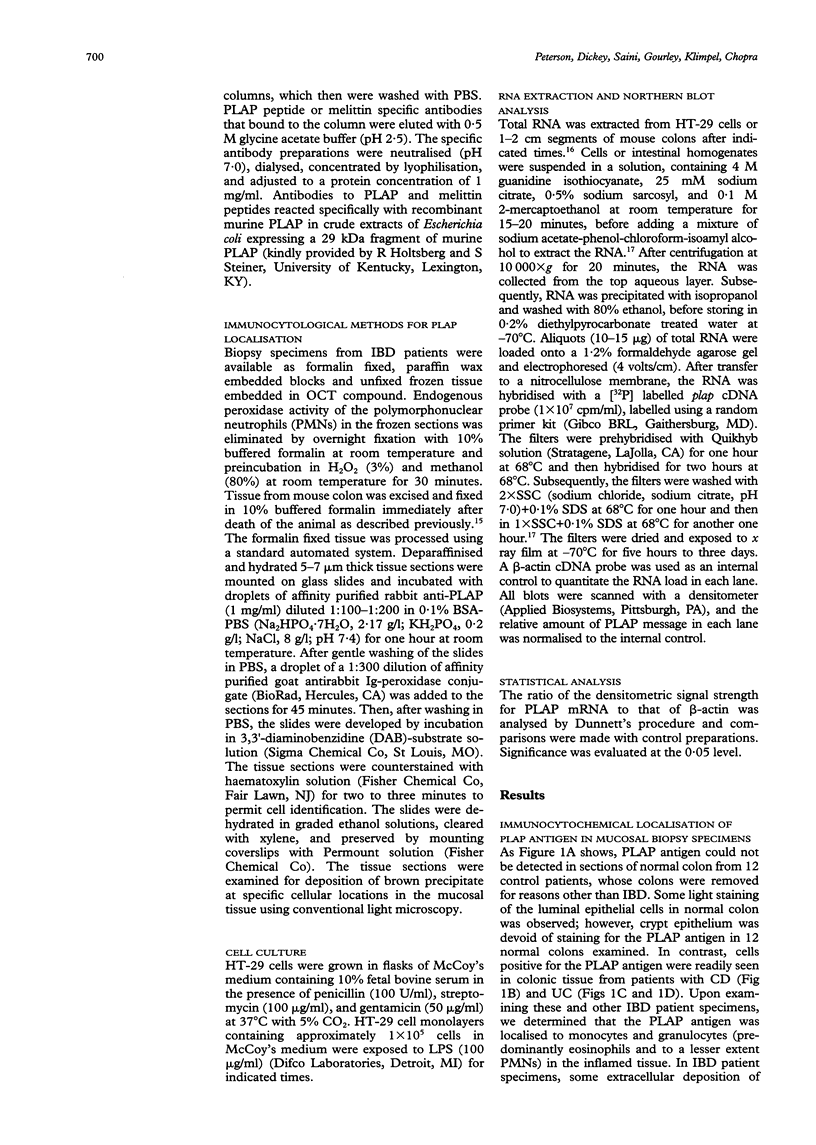

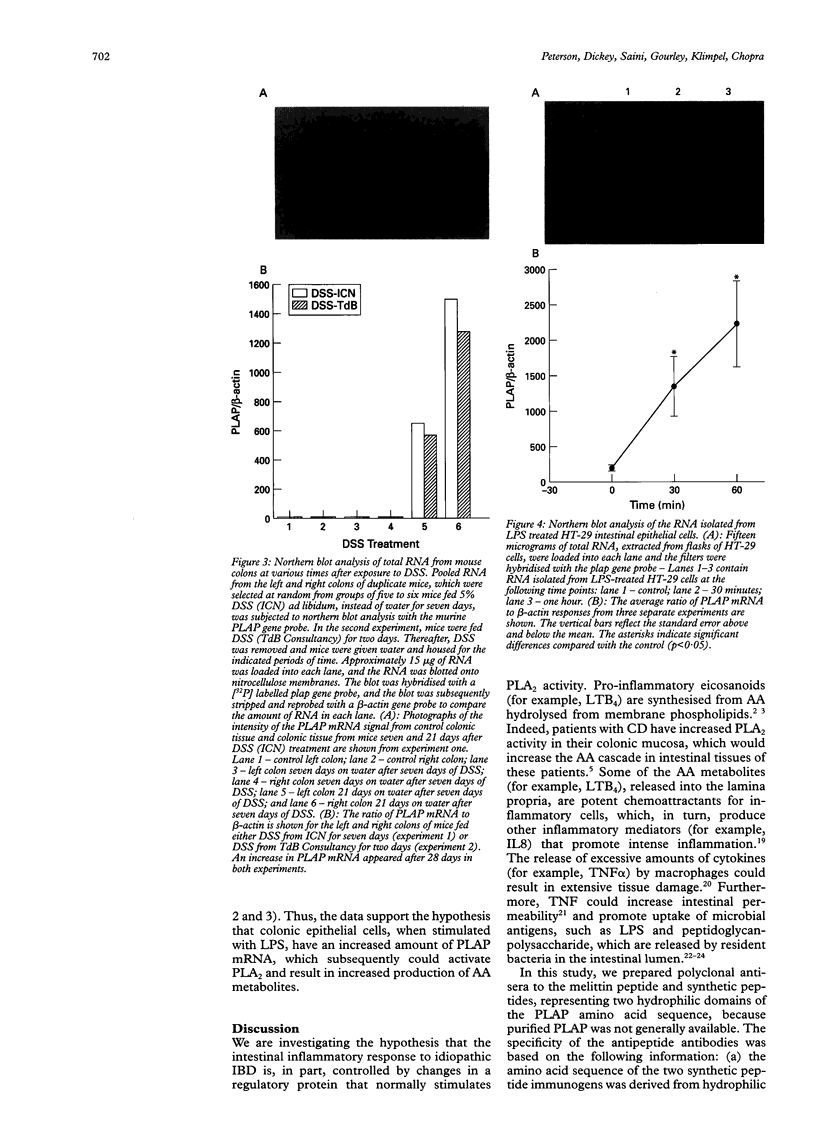
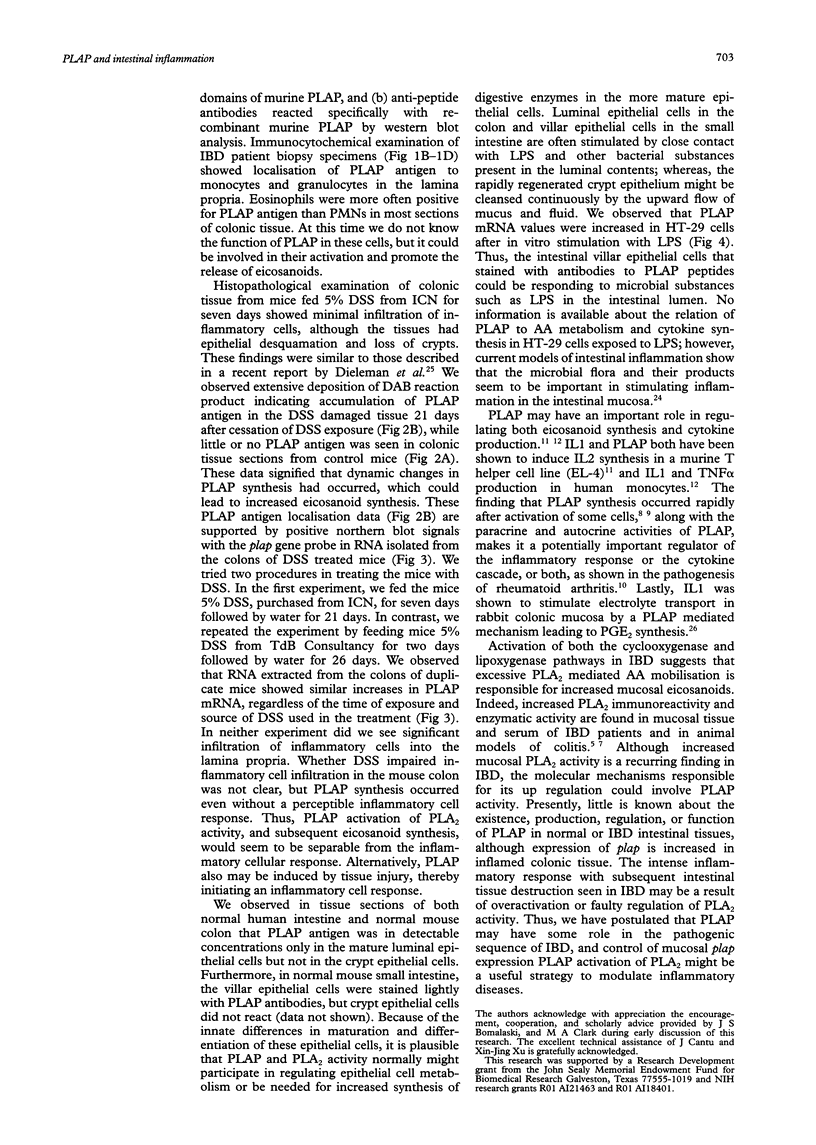
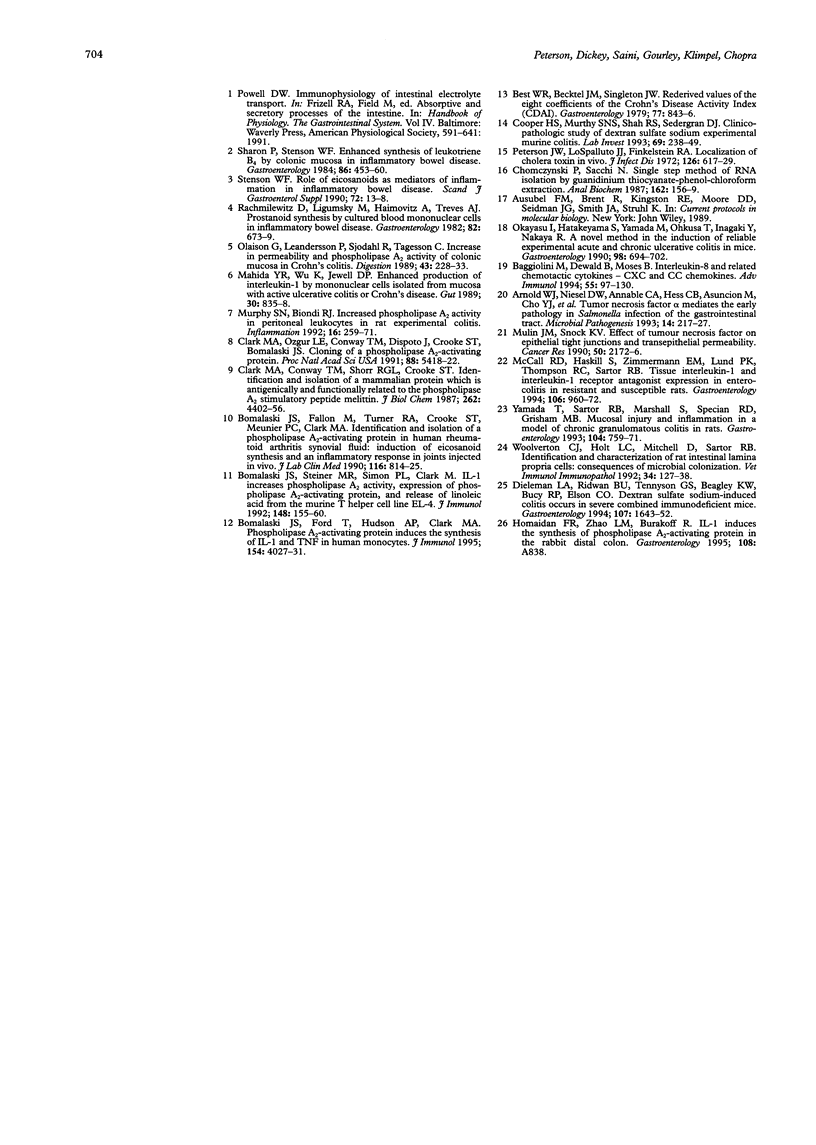
Images in this article
Selected References
These references are in PubMed. This may not be the complete list of references from this article.
- Arnold J. W., Niesel D. W., Annable C. R., Hess C. B., Asuncion M., Cho Y. J., Peterson J. W., Klimpel G. R. Tumor necrosis factor-alpha mediates the early pathology in Salmonella infection of the gastrointestinal tract. Microb Pathog. 1993 Mar;14(3):217–227. doi: 10.1006/mpat.1993.1021. [DOI] [PubMed] [Google Scholar]
- Baggiolini M., Dewald B., Moser B. Interleukin-8 and related chemotactic cytokines--CXC and CC chemokines. Adv Immunol. 1994;55:97–179. [PubMed] [Google Scholar]
- Best W. R., Becktel J. M., Singleton J. W. Rederived values of the eight coefficients of the Crohn's Disease Activity Index (CDAI). Gastroenterology. 1979 Oct;77(4 Pt 2):843–846. [PubMed] [Google Scholar]
- Bomalaski J. S., Fallon M., Turner R. A., Crooke S. T., Meunier P. C., Clark M. A. Identification and isolation of a phospholipase A2 activating protein in human rheumatoid arthritis synovial fluid: induction of eicosanoid synthesis and an inflammatory response in joints injected in vivo. J Lab Clin Med. 1990 Dec;116(6):814–825. [PubMed] [Google Scholar]
- Bomalaski J. S., Ford T., Hudson A. P., Clark M. A. Phospholipase A2-activating protein induces the synthesis of IL-1 and TNF in human monocytes. J Immunol. 1995 Apr 15;154(8):4027–4031. [PubMed] [Google Scholar]
- Bomalaski J. S., Steiner M. R., Simon P. L., Clark M. A. IL-1 increases phospholipase A2 activity, expression of phospholipase A2-activating protein, and release of linoleic acid from the murine T helper cell line EL-4. J Immunol. 1992 Jan 1;148(1):155–160. [PubMed] [Google Scholar]
- Chomczynski P., Sacchi N. Single-step method of RNA isolation by acid guanidinium thiocyanate-phenol-chloroform extraction. Anal Biochem. 1987 Apr;162(1):156–159. doi: 10.1006/abio.1987.9999. [DOI] [PubMed] [Google Scholar]
- Clark M. A., Conway T. M., Shorr R. G., Crooke S. T. Identification and isolation of a mammalian protein which is antigenically and functionally related to the phospholipase A2 stimulatory peptide melittin. J Biol Chem. 1987 Mar 25;262(9):4402–4406. [PubMed] [Google Scholar]
- Clark M. A., Ozgür L. E., Conway T. M., Dispoto J., Crooke S. T., Bomalaski J. S. Cloning of a phospholipase A2-activating protein. Proc Natl Acad Sci U S A. 1991 Jun 15;88(12):5418–5422. doi: 10.1073/pnas.88.12.5418. [DOI] [PMC free article] [PubMed] [Google Scholar]
- Cooper H. S., Murthy S. N., Shah R. S., Sedergran D. J. Clinicopathologic study of dextran sulfate sodium experimental murine colitis. Lab Invest. 1993 Aug;69(2):238–249. [PubMed] [Google Scholar]
- Dieleman L. A., Ridwan B. U., Tennyson G. S., Beagley K. W., Bucy R. P., Elson C. O. Dextran sulfate sodium-induced colitis occurs in severe combined immunodeficient mice. Gastroenterology. 1994 Dec;107(6):1643–1652. doi: 10.1016/0016-5085(94)90803-6. [DOI] [PubMed] [Google Scholar]
- Mahida Y. R., Wu K., Jewell D. P. Enhanced production of interleukin 1-beta by mononuclear cells isolated from mucosa with active ulcerative colitis of Crohn's disease. Gut. 1989 Jun;30(6):835–838. doi: 10.1136/gut.30.6.835. [DOI] [PMC free article] [PubMed] [Google Scholar]
- McCall R. D., Haskill S., Zimmermann E. M., Lund P. K., Thompson R. C., Sartor R. B. Tissue interleukin 1 and interleukin-1 receptor antagonist expression in enterocolitis in resistant and susceptible rats. Gastroenterology. 1994 Apr;106(4):960–972. doi: 10.1016/0016-5085(94)90755-2. [DOI] [PubMed] [Google Scholar]
- Mullin J. M., Snock K. V. Effect of tumor necrosis factor on epithelial tight junctions and transepithelial permeability. Cancer Res. 1990 Apr 1;50(7):2172–2176. [PubMed] [Google Scholar]
- Murthy S. N., Biondi R. J. Increased phospholipase A2 activity in peritoneal leukocytes in rat experimental colitis. Inflammation. 1992 Jun;16(3):259–271. doi: 10.1007/BF00918815. [DOI] [PubMed] [Google Scholar]
- Okayasu I., Hatakeyama S., Yamada M., Ohkusa T., Inagaki Y., Nakaya R. A novel method in the induction of reliable experimental acute and chronic ulcerative colitis in mice. Gastroenterology. 1990 Mar;98(3):694–702. doi: 10.1016/0016-5085(90)90290-h. [DOI] [PubMed] [Google Scholar]
- Olaison G., Leandersson P., Sjödahl R., Tagesson C. Increase in permeability and phospholipase A2 activity of colonic mucosa in Crohn's colitis. Digestion. 1989;43(4):228–233. doi: 10.1159/000199881. [DOI] [PubMed] [Google Scholar]
- Peterson J. W., LoSpalluto J. J., Finkelstein R. A. Localization of cholera toxin in vivo. J Infect Dis. 1972 Dec;126(6):617–628. doi: 10.1093/infdis/126.6.617. [DOI] [PubMed] [Google Scholar]
- Rachmilewitz D., Ligumsky M., Haimovitz A., Treves A. J. Prostanoid synthesis by cultured peripheral blood mononuclear cells in inflammatory diseases of the bowel. Gastroenterology. 1982 Apr;82(4):673–679. [PubMed] [Google Scholar]
- Sharon P., Stenson W. F. Enhanced synthesis of leukotriene B4 by colonic mucosa in inflammatory bowel disease. Gastroenterology. 1984 Mar;86(3):453–460. [PubMed] [Google Scholar]
- Stenson W. F. Role of eicosanoids as mediators of inflammation in inflammatory bowel disease. Scand J Gastroenterol Suppl. 1990;172:13–18. doi: 10.3109/00365529009091903. [DOI] [PubMed] [Google Scholar]
- Woolverton C. J., Holt L. C., Mitchell D., Sartor R. B. Identification and characterization of rat intestinal lamina propria cells: consequences of microbial colonization. Vet Immunol Immunopathol. 1992 Oct;34(1-2):127–138. doi: 10.1016/0165-2427(92)90156-k. [DOI] [PubMed] [Google Scholar]
- Yamada T., Sartor R. B., Marshall S., Specian R. D., Grisham M. B. Mucosal injury and inflammation in a model of chronic granulomatous colitis in rats. Gastroenterology. 1993 Mar;104(3):759–771. doi: 10.1016/0016-5085(93)91011-6. [DOI] [PubMed] [Google Scholar]





